Muon Tomography Chronology
This page contains a chronology of important events and reference works in the field of muon tomography. New entries for other works might be added later.
Some sources are temporary. More information, better sources and links for the publications will be added in time. Most of the links have the option to download the PDF file.
EDIT HISTORY:
Last Edit: 07-06-2019 -> 2013a, 2014
Events Edited: 1912, 1936, 1955, 1969, 1999, 2003a, 2003b, 2007, 2013b, 2017
Events Added : 1933 and 1950s
1912
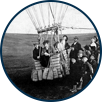 Cosmic Rays Discovery
Cosmic Rays Discovery
Austrian physicist Victor F. Hess discovers cosmic rays in a series of ascents in a hot-air balloon while looking for the source of the ionization radiation observed in the ground and in the atmosphere. His highest ascent was at 5.3 km of altitude. In 1936 he won the Nobel Prize for this discovery.
[More Info]>
1933
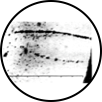 First Observation of a Muon
First Observation of a Muon
The evidence of the existence of muons was brought forward by Paul Kunze in a Wilson cloud chamber exposed to cosmic rays. Although at the time it was not know what particle produced the evidence. It was classified as a product of a nuclear explosion.
[More Info]>
1936
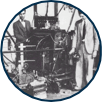 Muon Definitive Discovery
Muon Definitive Discovery
American physicist Carl D. Anderson and his graduate student Seth Neddermeyer discovered the existence of muon particles. The observations came from muons produced by cosmic rays. The muon was the first subatomic particle to be discoved.
[More Info]>
1950s
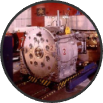 First Generation of Particle Accelerators
First Generation of Particle Accelerators
In this decade, the appearance of the first generation of particle accelerators brought major advances in the scientific knowledge about muons and its applicattions. One of these accelerators was CERN Synchrocyclotrons.
[More Info]>
1955
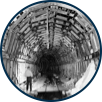 First Use of Muons
First Use of Muons
First reported use of cosmic ray muons by Eric George to measure the ice thickness above a tunnel in Australia, using a Geiger counter to measuse the ionization caused by the muons.
[More Info]>
1969
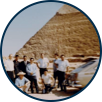 Muon Radiography in Chephren Pyramid
Muon Radiography in Chephren Pyramid
Muon radiography is used by Luis Alvarez team to look for hidden chambers in Chephren Pyramid in Egypt. The detection was made with spark chambers and scintillation counters. No additional chambers were found at that time.
[More Info]>
1987
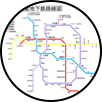 Measurement Depth of Nagoya Subway Tunnels
Measurement Depth of Nagoya Subway Tunnels
Minato et al. measured the depths of Nagoya subway tunnels using cosmic ray muons. The detectors used were based in scintillation counters. (Minato et al. 1987)
1999
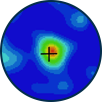 Moon Shadow is Imaged using Muons
Moon Shadow is Imaged using Muons
At the Soudan II detector in Minnesota, using drift tubes and at an undergroud depth of 700m, the Moon shadow is imaged using muon flux.
[More Info]>
2003
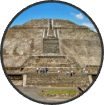 Inspection of the Pyramid of the Sun
Inspection of the Pyramid of the Sun
The preparations on a muon detector system are iniciated to inspect the interior of the Pyramid of the Sun in Mexico. The detection system uses scintillator counters and MWPCs.
[More Info]>
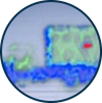 Beginning of Muon Scattering Tomography - Portal Scanner
Beginning of Muon Scattering Tomography - Portal Scanner
At LANL, a seminal work on utilising Coulomb scattering of muons to identify high-Z objects is made aiming the detection of nuclear threats. A real size portal scanner was implemented in the Freeport (Bahamas) to scan cargo trucks.
[More Info]>
2007
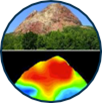 Density Measurement of Mt. Asama and Showa-Shinzan dome
Density Measurement of Mt. Asama and Showa-Shinzan dome
Muon radiography is used to measure an average density profile of Mt. Asama and the Showa-Shinzan dome, both in Japan. The detection method used is based on emulsion cloud chambers.
[More Info]>
2008
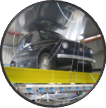 LNL Muon Scattering Tomography Telescope
LNL Muon Scattering Tomography Telescope
To test the viability of detecting high-Z objects, the Legnaro National Laboratory in Italy built a muon scattering tomography telescope prototype and tested a working vehicle between the detectors. (CMTp)
2009
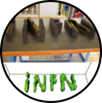 INFN Muon Tomography System
INFN Muon Tomography System
The large-volume muon tomography system, built by INFN, demonstrates the possibility of material discrimination. The system is based on drift chambers. (Presente et al. 2009)
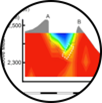 Density Profile of a Volcano Interior
Density Profile of a Volcano Interior
The density profile of the interior of a volcano in Japan is imaged with cosmic ray muography combined with classical gravimetry by Okudo and Tanaka. (Okubo and Tanaka, 2012)
2012
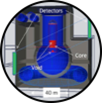 Fukushima-Daiichi Plant Interior Simulation
Fukushima-Daiichi Plant Interior Simulation
Simulation studies show the feasibility of identifying voids and movements of the material inside the reactor core at the stricken Fukushima-Daiichi plant. (Borozdin et al. 2010)
2013
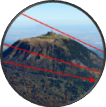 Puy de Dôme Volcano Structure Study
Puy de Dôme Volcano Structure Study
Cristina Cârloganu used muon transmission tomography to study the volcanic dome interior Puy de Dôme, in France. The muography obtained could be correlated with the geological strutures observed in site.
[More Info]>
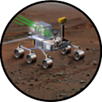 Muon Tomography in Mars
Muon Tomography in Mars
The California Institute of Technology proposed the use muons to map the terrain of Mars. Studies found that muon flux present on martian atmosphere is on par with what is observed in the Earth atmosphere.
[More Info]>
2014
 Palazzo della Loggia Monitorization
Palazzo della Loggia Monitorization
A monitorization system based in muon tomography is installed at Palazzo della Loggia, dating from 1574 in Italy, to monitoring the integral stability of this historical building.
[More Info]>
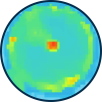 Nuclear Waste Control
Nuclear Waste Control
The first images of encapsulated nuclear waste were obtained by the Sellafield Muon Tomography project using a small-scale prototype detector system in Glasgow. (Clarkson et al. 2014)
2016
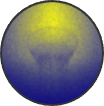 WatTo Experiment
WatTo Experiment
A muon transmission tomography telescope was set in place pointing in the direction of Saclay water tower, in France, aiming to detect density variations due to water rise and drop levels inside the tower. (Bouteille el al. 2016)
2017
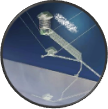 ScanPyramids Project - Cheops Pyramid New Chamber
ScanPyramids Project - Cheops Pyramid New Chamber
With the aim of studing the interior of Egypt pyramids, muon transmisson tomography was used in Cheops Great Pyramid. The findings showed the existence of a previously unknown chamber above the Great Gallery.
[More Info]>
